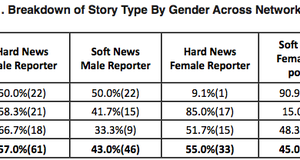From Elon Journal of Undergraduate Research in Communications VOL. 5 NO. 1Revolutionizing the Newsroom: How Online and Mobile Technologies Have Changed Broadcast Journalism
IN THIS ARTICLE
KEYWORDS
AbstractThis study interviewed journalists across the United States in 2013 to find out how online and mobile technologies have changed television journalism in the past decade and what new technologies and trends they expect in the future. Interviews with thirteen television journalists indicate that web presence and mobile apps are getting more important in most cases; the use of others’ digital assets for both television broadcast and the web; use of the Internet and social networking to generate better stories; and an effort to reach out to younger audience. The results of this study also imply the need for journalists to learn new technology, change daily work habits, and adapt to new job requirements in order to maintain job security and succeed in their career. IntroductionThe field of communications changes constantly, from the introduction of the printing press, to radio, to television, to the Internet, to mobile, and beyond. In order to communicate effectively, especially in journalism, one must continue to adapt. Regardless, the interview is still the most widely accepted and practiced process in the journalism field. The study uses interview method to take a closer look at how changing technology impacts the inner workings of television journalism companies and newsrooms. By asking current professionals how new technology has changed the television news profession in the past decade, and asking their opinions on the future of the industry, this paper tried to determine whether U.S. television journalism has made a massive move to online and mobile devices, making the job of journalists increasingly more dynamic and changing the fundamental duties of journalists to include these new elements. BackgroundIn order to properly understand the future of television journalism, one must understand how it grew to where it is today. The past tells us that technology causes journalism to change. In the mid-nineteenth century, the telegraph allowed news publishers to gather and send information across the globe faster than ever before. By the early twentieth century, the camera could create photographic images of people and events that readers had never been able to see.1 In the past forty years, most afternoon newspapers have disappeared, people’s primary news sources have shifted from paper, to television, to the Internet, and our ways of understanding the news has completely changed.2 As Giles and Snyder explain, “We cannot take the future for granted . . . it is very difficult to determine what is around the next bend in the road—especially in a field as integrally connected with changes in culture, politics, technology and economics as journalism.” As new technology is invented and becomes popular, many believe the old technology will go away, but rather the technology has changed and expanded over time.3 4 In particular, the Internet allows journalism to change, expand, and adapt with the advent of new technologies. John Naughton explains this phenomenon in his book A Brief History of the Future: The Origins of the Internet: The Internet is one of the most remarkable things human beings have ever made. In terms of its impact on society, it ranks with print, the railways, the telegraph, the automobile, electric power and television. Some would equate it with print and television, the two earlier technologies that most transformed the communications environment in which people live. Yet it is potentially more powerful than both because it harnesses the intellectual leverage which print gave to mankind without being hobbled by the one-to-many nature of broadcast television.5 Information about technology and media’s future can be found from many sources beyond Naughton’s book. For example, in November of 2013 the Wall Street Journal posted a video entitled “How is Mobile Consumption Changing Journalism?” in which top professionals at online reporting companies such as Circa, Buzzfeed, NewsCorp and Mashable were interviewed. Anthony De Rosa from the news app Circa explained there must be a change in newsrooms dealing with the online and mobile changes. “It takes a culture change and a shift in the newsroom,” De Rosa said. “How do I take this story and make it really useful for someone who’s on their phone? I think the newsroom itself has to take that information and synthesize it in a different way, and produce it in a different format.” Raju Narisetti, the Senior Vice-President of Strategy News Corp, agreed. “We have to think of very different ways to engage them,” he said. “I think that is where there’s a little bit of a disconnect with newsrooms that are so focused on the journalism only without worry about the experience.” These challenges and changes prompted this study to find out how professionals are adapting to the new technology. Literature ReviewMany studies regarding how changing technologies impact broadcast journalism were conducted in the early 2000s, when the Internet began to have a strong presence in the world of news media. Since its invention, the Internet has become the most popular means of communicating news, and has increasingly changed journalists’ job and their impacts on their audience, along with the subsequent advent of mobile technology. In 2001, Bardoel and Deuze further explored the endless technological possibilities of the Internet and how a new occupation and industry had been created: digital and online journalism.6 In another study, Deuze analyzed the first generation of news media online to find that online journalism was a “fundamentally different” type of journalism, particularly because it involved a new platform to share information that must constantly be kept in mind for journalists in the future.7 As Henry Jenkins correctly predicted in the 2001 MIT Technology Review, “. . . media will be everywhere, and we will use all kinds of media in relation to one another.”8 Giles and Snyder also supported this prediction in Problems and Prospects of Journalism: What’s Next? by compiling essays from experts in the United States who recognized how journalism would likely change with the Internet, and predicted it would be the future of news.9 Recent research on this topic has come from the Pew Research Center, which has focused on the impact of the Internet on local and network markets. Jurkowitz and Matsa from the Pew Research Journalism Project warned that though local television stations have become a “hot commodity” among large media companies, their strength has decreased because of trends that put them behind many other competitors. Television news is losing significant portions of its audience, particularly young viewers, and lagging in digital revenue.10 Furthermore, Sasseen, Olmstead, and Mitchell of the Pew Research Center described how journalists have become dependent on the technical industry and mobile giants in order to reach viewers. However, they explained that news, in general, still holds out hope because most audience members return to legacy newspapers and television stations for their information.11 The literature review above shows that the destiny of news will be shaped by the future of online and mobile resources. The important question is how much media professionals understand the importance of online and mobile news and how much they are able to embrace them. To investigate this question, the author interviewed media professionals across the country. MethodsTo explore the future of television journalism on the network and local level and provide insights of journalists, the author tried to understand the impact of the Internet and mobile capabilities and discover what news professionals expect to change with new technology and ideas in the future. The author interviewed media professionals throughout the United States on the network and local television levels to ask about the industry’s responses to mobile and online capabilities, their prediction on how the television industry will continue to change in the future. The following three questions were asked of all interviewees for analysis and comparison:12
The interview was chosen because this method is widely accepted as suitable for qualitative research. The qualitative research interview seeks to describe and understand the meanings of central themes in the life and world of the subjects. The interviewer’s main task is to understand the meaning of what the interview-ees say.13 Again, this study uses interviews to evaluate and organize qualitative data on the impact of technology on newsrooms across the country and to predict what new technology may come next. FindingsThis section was organized based on interviewees’ answers to the three questions asked above. Job changes due to online and mobile news, including a web presenceOnline and mobile technologies play an increasingly prominent role in television newsrooms, particularly on the local level. All but one journalist in this study emphasized the importance of having an online component along with an on-air news broadcast. Many of the local journalists explained their stations have gone “web first,” which demonstrates how much the industry has changed from having only on-air broadcasts in the 1990s to web pages for most stations, to interactive web sites and mobile apps, which have become standard for many stations across the country.14 15 On the local level, reporters are responsible for all on-air and web content regarding their story, including a print style web article.16 17 18 At WVEC-TV in Norfolk, Virginia, one reporter explained how his mobile app is on track to getting more monthly views than his station’s website, a sign of how quickly mobile devices have been adopted and become important in the distribution of television news.19 At KLBK-TV in Lubbock, Texas, the general manager requires at least fifty local stories be posted online every day.20 On the network level, journalists bring a new value to their website by adding materials beyond the on-air broadcasts. For example, producers21 at CBS This Morning are encouraged to supply “web extras” to their stories, including parts of stories that did not make it on the air, but may be complementary to the final product online and on mobile platforms, including extra b-roll22 and parts of interviews23. Matt Samuels, broadcast associate at CBS Sunday Morning, however, explained that the Internet did not have as much of an impact on his work because the shows appeals to an older audience that does not have a strong affiliation with the web. Network producers also deal with complicated copyright issues on the Internet. Music, still photographs and footage licensed for particular news or feature segments are often cleared just for television broadcast, but not for the Internet. Therefore, some segments are restricted from the web. With that in mind, producers are now trying to secure rights and clearances for both their broadcast and online stories when negotiating for them.24 According to Meggie Miao, producer at CBS Sunday Morning, she took the extra step to obtain all necessary rights and clearances to use all content online, too. “I try to negotiate all the rights to license the piece on air as well as online,” she said. “For instance, the story I produced is on surrealist painter Magritte. I had to obtain all the rights so we can post the story to the web, which has in turn gotten over 1600 Facebook recommends, lots of tweets, etc.” Miao and other producers at the network level believe the rights issue must be resolved in order for their shows to truly succeed online.25 On both levels, information is no longer held for on-air broadcasts first. When information is received, it is immediately confirmed and distributed online. This new norm challenges traditional news media to change the culture of reporting so that data and information get processed and made available instantly to the audience. Today’s viewers consume the news on multiple platforms.26 Susan Zirinsky, executive producer of 48 Hours, mentioned the benefits from these changes, including the ability to share information with more people because of the wide variety of platforms available. Additionally, Zirinsky explained, everything has a second screen. This experience impacts television news drastically. The ability to interact with viewers while on the air increases communication and allows for additional information to be shared. It also provides the opportunity to build a new audience and expand the reach of the show.27 However, news professionals today are not solely using the Internet to share news content. All of those interviewed explained they use the Internet on a daily basis in order to look for story ideas, photos and facts. David Rothman, producer at CBS Sunday Morning, explained how he uses social networking and local affiliates to reach out and find characters for stories across the country. I am constantly looking for stories/characters/facts online. I use Facebook/Twitter/Meetups to find characters in localities that I am travelling to- for example, I was working on a Tabasco story, and needed to interview Tabasco fans in New Orleans- so I asked both the local New Orleans affiliate and the official Tabasco Facebook administrators if I could post on their pages a “Call for Tabasco fans.” Conversely, Zirinsky described a different perspective on a journalist’s web presence: Am I required to have it? No. But it’s like do you get up in the morning and brush your teeth? You know in the world today that’s part of who we are. We have a web presence. We developed “Crimesider” the crime blog because we felt that there was no one in the space that was a true all purpose law and justice website. So I think it’s not that somebody says you’re required, it’s just like wearing underwear. You know, you wouldn’t leave home without it. Web presence is strongly enforced on the local level. Every local journalist who was interviewed for this study, reporters and producers alike, is required to have a professional web presence for their jobs. On the network level, presence is not required but highly encouraged. Journalists today compete with social networks for attention from viewers. Shelly Slater, reporter and anchor from WFAA-TV in Dallas, Texas, explained her web presence as vital to her job because it allows her to reach out and connect with younger audience members about news on platforms like Facebook and Twitter. She can break into those demographics that use social media as primary sources for their information.28 According to the Pew Research Journalism Project, thirty percent of United States adults consume news on Facebook, and seventy-eight percent of those adults mostly see news when they are on Facebook for other reasons.29 Forty-five percent of Americans own a smart phone today. Of that forty-five percent, thirty-six percent get news on their device daily. These statistics are almost identical for thirty-one percent of Americans who own tablets. Thirty-seven percent of these tablet owners use their device to get news daily.30 The Internet and mobile have become staples in many people’s daily lives in the United States, and has changed their consumption of television news, particularly at the local level. The next question explores how this technology has changed the newsroom.Continued on Next Page » Suggested Reading from Inquiries Journal
Inquiries Journal provides undergraduate and graduate students around the world a platform for the wide dissemination of academic work over a range of core disciplines. Representing the work of students from hundreds of institutions around the globe, Inquiries Journal's large database of academic articles is completely free. Learn more | Blog | Submit Latest in Business & Communications |



















